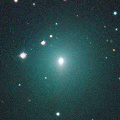
|
Brightening very rapidly. Now it is very bright as 8.4 mag (Mar. 14, Maik Meyer). It moves along the same orbit as C/1844 Y1 (Great Comet). It approaches to Sun down to 0.25 a.u. on May 30. It is expected to brighten up to -1 mag. In the Northern Hemisphere, it stays observable in excellent condition until mid May when it brightens up to 2 mag. In the Southern Hemisphere, it is not observable until June.
Date(TT) R.A. (2000) Decl. Delta r Elong. m1 Best Time(A, h)
Mar. 14 10 2.13 65 12.2 1.124 1.789 115 9.1 22:29 (180, 60)
Mar. 21 9 15.84 67 29.4 1.087 1.670 106 8.0 21:16 (180, 57)
|
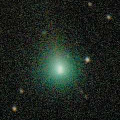
|
Now it is very bright as 7.8 mag (Mar. 14, Maik Meyer). It stays bright as 8-9 mag until mid April. In the Northern Hemisphere, it stays observable for a long time, although it becomes extremely low in March. In the Southern Hemisphere, it is not observable until June when it fades down to 15 mag. It seems to be a fragment of C/1988 A1 (Liller), like C/1996 Q1 (Tabur) and C/2015 F3 (SWAN).
Date(TT) R.A. (2000) Decl. Delta r Elong. m1 Best Time(A, h)
Mar. 14 0 4.01 29 6.1 1.488 0.838 32 8.5 19:30 (122, 6)
Mar. 21 0 8.40 35 39.7 1.426 0.844 35 8.4 19:36 (131, 6)
|
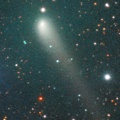
|
Now it is 8.8 mag (Mar. 14, Maik Meyer). It stays bright as 8-9 mag until July. It is observable in good condition in the Northern Hemisphere. In the Southern Hemisphere, it is not observable until July.
Date(TT) R.A. (2000) Decl. Delta r Elong. m1 Best Time(A, h)
Mar. 14 2 22.22 63 58.9 1.767 1.759 73 8.6 19:30 (148, 40)
Mar. 21 2 34.03 65 42.4 1.772 1.725 70 8.5 19:36 (150, 38)
|
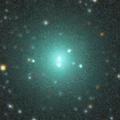
|
It brightened up to 10.2 mag in February (Feb. 6, Maik Meyer). Now it is fading rapidly. It has already faded down to 13.4 mag (Mar. 15, Sandor Szabo). It is observable in good condition in the Northern Hemisphere. It is not observable in the Southern Hemisphere.
Date(TT) R.A. (2000) Decl. Delta r Elong. m1 Best Time(A, h)
Mar. 14 4 15.24 67 4.5 1.177 1.468 84 12.0 19:30 (156, 51)
Mar. 21 4 55.52 59 26.4 1.345 1.550 81 12.5 19:36 (146, 55)
|

|
Now it is 13.3 mag (Feb. 28, Sandor Szabo). It stays bright as 12-13 mag until summer. But it becomes low in spring. In the Southern Hemisphere, it will never be observable again.
Date(TT) R.A. (2000) Decl. Delta r Elong. m1 Best Time(A, h)
Mar. 14 0 8.67 49 28.5 3.858 3.347 52 12.6 19:30 (138, 19)
Mar. 21 0 15.60 51 2.2 3.910 3.372 50 12.7 19:36 (142, 16)
|
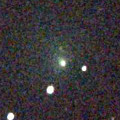
|
Now it is very bright as 13.0 mag (Mar. 14, Michael Mattiazzo). It is a comet evidently. It will approach to Sun down to 0.9 a.u. in June, and it is extected to brighten up to 8.5 mag. In the Southern Hemisphere, it stays observable in good condition for a long time after this. In the Northern Hemisphere, it will be unobservable from late March to late June.
Date(TT) R.A. (2000) Decl. Delta r Elong. m1 Best Time(A, h)
Mar. 14 4 1.60 -24 54.7 1.975 1.840 67 13.9 19:30 ( 42, 17)
Mar. 21 4 6.85 -24 24.0 1.940 1.751 64 13.6 19:36 ( 47, 13)
|

|
It has not been observed yet in this apparition. The condition of this apparition is bad, and it it not observable before the perihelion passage. It will appear in the morning sky at 12 mag in mid April in the Northern Hemisphere, or at 15 mag in mid May in the Southern Hemisphere. However, it will fade out rapidly, and will be fainter than 18 mag in June.
Date(TT) R.A. (2000) Decl. Delta r Elong. m1 Best Time(A, h)
Mar. 14 0 11.54 -3 31.8 1.705 0.739 8 14.9 19:30 ( 94,-11)
Mar. 21 0 44.68 0 37.7 1.602 0.649 10 13.7 19:36 ( 98, -9)
|
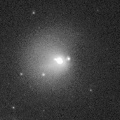
|
It brightened in outburst on Feb. 3. It is bright as 13.0 mag still now (Feb. 18, Toshihiko Ikemura, Hirohisa Sato). It is already unobservable in the Southern Hemisphere. It will be unobservable in mid March also in the Northern Hemisphere.
Date(TT) R.A. (2000) Decl. Delta r Elong. m1 Best Time(A, h)
Mar. 14 1 9.85 15 56.0 6.637 5.793 29 13.8 19:30 (102, 11)
Mar. 21 1 15.18 16 25.0 6.688 5.794 24 13.8 19:36 (106, 6)
|
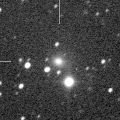
|
Now it is bright as 13.8 mag (Dec. 28, Chris Wyatt). It stays 14 mag until spring. It stays observable for a long time in the Southern Hemisphere. It is not observable until August in the Northern Hemisphere.
Date(TT) R.A. (2000) Decl. Delta r Elong. m1 Best Time(A, h)
Mar. 14 1 43.57 -53 55.9 3.997 3.564 57 14.4 19:30 ( 39,-22)
Mar. 21 1 52.10 -51 40.7 4.028 3.582 56 14.4 19:36 ( 43,-24)
|
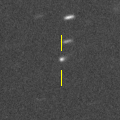
|
Now it is 14.7 mag (Mar. 15, Sandor Szabo). It will brighten up to 13.5-14 mag from 2020 to 2021. It stays observable in good condition for a while.
Date(TT) R.A. (2000) Decl. Delta r Elong. m1 Best Time(A, h)
Mar. 14 13 8.73 15 58.3 2.451 3.371 153 14.5 1:42 ( 0, 71)
Mar. 21 13 4.56 16 32.4 2.413 3.354 157 14.4 1:11 ( 0, 71)
|
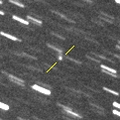
|
Now it is 15.9 mag (Dec. 26, M. Mattiazzo). In the Southern Hemisphere, it is observable at 14.5 mag from winter to spring. In the Northern Hemisphere, it is not observable until August when it fades down to 17 mag.
Date(TT) R.A. (2000) Decl. Delta r Elong. m1 Best Time(A, h)
Mar. 14 2 39.28 -48 43.7 2.344 2.045 60 14.5 19:30 ( 38,-11)
Mar. 21 2 57.43 -44 1.1 2.391 2.062 58 14.5 19:36 ( 43,-10)
|
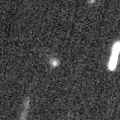
|
Now it is 14.4 mag (Mar. 28, Sandor Szabo). It will brighten up to 10.5 mag from 2020 December to 2021 January. In the Northern Hemisphere, it stays observable in good condition while the comet will be brightening gradually, but it is not observable at the high light. In the Southern Hemisphere, it is not observable for a long time, but it will be observable in good condition after the high light.
Date(TT) R.A. (2000) Decl. Delta r Elong. m1 Best Time(A, h)
Mar. 14 18 43.79 69 15.0 3.505 3.585 86 14.8 4:48 (199, 50)
Mar. 21 18 41.07 71 2.4 3.435 3.519 86 14.6 4:37 (196, 50)
|
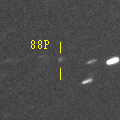
|
Now it is 15.8 mag (Feb. 23, Toshihiko Ikemura, Hirohisa Sato). Brightening very rapidly. It will brighten up to 8-9 mag from summer to autumn. It will be observable in excellent condition in the Southern Hemisphere. It locates very low around the high light in the Northern Hemisphere.
Date(TT) R.A. (2000) Decl. Delta r Elong. m1 Best Time(A, h)
Mar. 14 13 40.60 -5 6.2 1.451 2.354 148 15.2 2:14 ( 0, 50)
Mar. 21 13 37.06 -4 42.8 1.363 2.308 155 14.9 1:43 ( 0, 50)
|
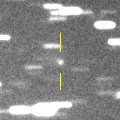
|
First return of a new periodic comet discovered in 2006. It brightened up to 14.9 mag in January (Jan. 21, R. Fichtl). It will never be observable after this.
Date(TT) R.A. (2000) Decl. Delta r Elong. m1 Best Time(A, h)
Mar. 14 0 47.14 -4 28.1 2.622 1.702 17 15.6 19:30 ( 88, -5)
Mar. 21 1 6.59 -2 57.5 2.632 1.700 16 15.6 19:36 ( 91, -7)
|
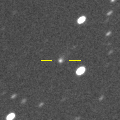
|
Now it is 16.1 mag (Feb. 20, Toshihiko Ikemura, Hirohisa Sato). It will brighten up to 13 mag in 2021. In 2020, it is observable at 15 mag in good condition from spring to summer.
Date(TT) R.A. (2000) Decl. Delta r Elong. m1 Best Time(A, h)
Mar. 14 14 59.44 -17 15.9 4.773 5.419 126 15.7 3:33 ( 0, 38)
Mar. 21 14 57.00 -17 43.3 4.641 5.377 133 15.6 3:03 ( 0, 37)
|
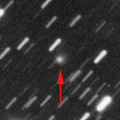
|
Now it is 15.4 mag (Feb. 20, Toshihiko Ikemura, Hirohisa Sato). It is expected to be observable at 5-6 mag for a long time from 2022 to 2023. In the Northern Hemisphere, it is not observable at the high light from 2022 summer to 2023 summer. In the Southern Hemisphere, it stays unobservable for a while. But it will be observable in good condition at the high light.
Date(TT) R.A. (2000) Decl. Delta r Elong. m1 Best Time(A, h)
Mar. 14 18 18.21 48 25.8 9.644 9.609 85 15.7 4:48 (230, 64)
Mar. 21 18 18.95 48 57.9 9.558 9.559 87 15.7 4:37 (226, 66)
|

|
Now it is 14.6 mag (Dec. 28, Chris Wyatt). It will be fading slowly after this. In the Southern Hemisphere, it becomes low from February to March, but it stays observable for a long time. In the Northern Hemisphere, it is not observasble until June.
Date(TT) R.A. (2000) Decl. Delta r Elong. m1 Best Time(A, h)
Mar. 14 23 28.20 -39 31.0 4.429 3.684 37 15.9 4:48 (297,-34)
Mar. 21 23 34.21 -38 13.0 4.439 3.717 38 16.0 4:37 (297,-32)
|

|
It brightened up to 7.7 mag in June in 2018 (June 19, Juan Jose Gonzalez). Now it is fading. It has already faded down to 15.8 mag (Feb. 18, Toshihiko Ikemura, Hirohisa Sato). In the Southern Hemisphere, it stays observable for a long time until the comet will fade out. In the Northern Hemisphere, it stays low for a while.
Date(TT) R.A. (2000) Decl. Delta r Elong. m1 Best Time(A, h)
Mar. 14 5 30.48 -20 36.4 6.160 6.200 87 16.1 19:30 ( 24, 31)
Mar. 21 5 31.15 -19 28.2 6.302 6.255 82 16.2 19:36 ( 33, 28)
|
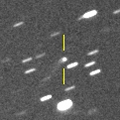
|
Now it is 15.8 mag (Oct. 5, Toshihiko Ikemura, Hirohisa Sato). It stays 15-16 mag for a long time until 2021.
Date(TT) R.A. (2000) Decl. Delta r Elong. m1 Best Time(A, h)
Mar. 14 20 49.46 -6 0.9 5.234 4.541 41 16.2 4:48 (288, 14)
Mar. 21 20 51.49 -4 47.4 5.140 4.532 47 16.1 4:37 (289, 17)
|
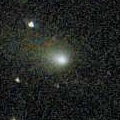
|
Now it is 15.5 mag (Feb. 18, Sandor Szabo). It will be fading after this, and will be fainter than 18 mag in May. In the Northern Hemisphere, it is observable in excellent condition. It locates low in the Southern Hemisphere.
Date(TT) R.A. (2000) Decl. Delta r Elong. m1 Best Time(A, h)
Mar. 14 5 26.13 12 53.5 1.402 1.691 88 16.3 19:30 ( 49, 60)
Mar. 21 5 43.09 12 17.7 1.482 1.717 85 16.5 19:36 ( 54, 56)
|
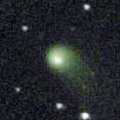
|
It will be fading slowly after this. In the Southern Hemisphere, it stays observable in good condition for a long time. It will never be observable after this in the Northern Hemisphere.
Date(TT) R.A. (2000) Decl. Delta r Elong. m1 Best Time(A, h)
Mar. 14 12 11.66 -76 33.8 4.748 5.029 100 16.4 0:47 ( 0,-22)
Mar. 21 11 36.28 -76 33.1 4.747 5.075 103 16.4 23:35 ( 0,-22)
|
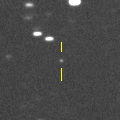
|
Now it is 15.9 mag (Feb. 18, Toshihiko Ikemura, Hirohisa Sato). It will brighten up to 16 mag in March, and it will be observable in good condition.
Date(TT) R.A. (2000) Decl. Delta r Elong. m1 Best Time(A, h)
Mar. 14 10 35.40 34 24.0 0.786 1.699 145 16.4 23:04 ( 0, 89)
Mar. 21 10 22.23 30 34.6 0.788 1.684 141 16.4 22:24 ( 0, 85)
|
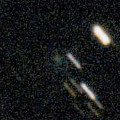
|
Now it is 16.6 mag (Feb. 19, Toshihiko Ikemura, Hirohisa Sato). It stays 16.5 mag until late March. It is not observable in the Southern Hemisphere.
Date(TT) R.A. (2000) Decl. Delta r Elong. m1 Best Time(A, h)
Mar. 14 2 24.82 28 28.4 1.909 1.496 50 16.4 19:30 (104, 33)
Mar. 21 2 47.13 31 0.1 1.957 1.517 49 16.5 19:36 (108, 32)
|
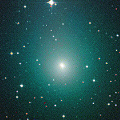
|
It brightened up to 8.3 mag in September (Sept. 20, Maik Meyer). Now it is fading. It has already faded down to 14.9 mag (Dec. 28, Chris Wyatt). In the Southern Hemisphere, it stays observable for a long time after this. In the Northern Hemisphere, it will never be observable again.
Date(TT) R.A. (2000) Decl. Delta r Elong. m1 Best Time(A, h)
Mar. 14 23 36.77 -51 33.5 3.442 2.889 49 16.4 4:48 (311,-39)
Mar. 21 23 47.78 -52 30.0 3.454 2.960 52 16.6 4:37 (313,-38)
|
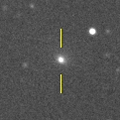
|
Now it is 15.9 mag (Feb. 18, Toshihiko Ikemura, Hirohisa Sato). It will be fading slowly after this.
Date(TT) R.A. (2000) Decl. Delta r Elong. m1 Best Time(A, h)
Mar. 14 2 27.50 10 50.8 3.009 2.404 44 16.5 19:30 ( 86, 24)
Mar. 21 2 40.76 12 3.6 3.078 2.418 41 16.5 19:36 ( 91, 21)
|
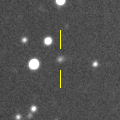
|
Now it is 16.4 mag (Feb. 23, Toshihiko Ikemura, Hirohisa Sato). It stays observable at 17 mag from 2020 to 2021. It locates somewhat low in the Northern Hemisphere.
Date(TT) R.A. (2000) Decl. Delta r Elong. m1 Best Time(A, h)
Mar. 14 10 47.07 -23 38.2 5.702 6.591 151 16.5 23:17 ( 0, 31)
Mar. 21 10 45.25 -23 4.2 5.703 6.588 150 16.5 22:47 ( 0, 32)
|
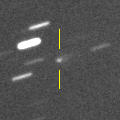
|
Now it is 16.8 mag (Feb. 18, Toshihiko Ikemura, Hirohisa Sato). It brightens up to 16.5 mag and will be observable in good condition from March to April.
Date(TT) R.A. (2000) Decl. Delta r Elong. m1 Best Time(A, h)
Mar. 14 13 31.57 -0 45.6 1.222 2.147 151 16.6 2:05 ( 0, 54)
Mar. 21 13 28.70 -0 23.8 1.197 2.155 158 16.5 1:35 ( 0, 54)
|
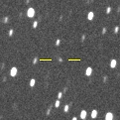
|
Now it is 17.2 mag (Feb. 20, Toshihiko Ikemura, Hirohisa Sato). It will stay at 14 mag for a long time from 2021 to 2022. In the Northern Hemisphere, it stays observable in good condition while brightening gradually. In the Southern Hemisphere, it is appearing in the morning sky. But it stays locating low for a long time.
Date(TT) R.A. (2000) Decl. Delta r Elong. m1 Best Time(A, h)
Mar. 14 19 14.98 30 46.6 6.975 6.708 70 16.6 4:48 (263, 52)
Mar. 21 19 15.68 31 8.6 6.877 6.675 74 16.6 4:37 (265, 56)
|

|
It looks cometary on the LCO (CTIO) image on Aug. 21, 2019. Now it is 16.2 mag (Oct. 2, ATLAS-MLO, Mauna Loa). It is appearing in the mornign sky in the Southern Hemisphere. It will be observable in late March also in the Northern Hemisphere.
Date(TT) R.A. (2000) Decl. Delta r Elong. m1 Best Time(A, h)
Mar. 14 20 11.11 -30 28.8 7.043 6.538 55 16.7 4:48 (312, 4)
Mar. 21 20 11.29 -30 18.5 6.945 6.548 62 16.7 4:37 (315, 7)
|
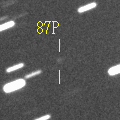
|
Now it is 17.4 mag (Feb. 20, Toshihiko Ikemura, Hirohisa Sato). It will brighten up to 17 mag and will be observable in excellent condition from March to May.
Date(TT) R.A. (2000) Decl. Delta r Elong. m1 Best Time(A, h)
Mar. 14 12 58.01 -5 51.9 1.186 2.140 157 17.2 1:32 ( 0, 49)
Mar. 21 12 55.12 -5 19.4 1.151 2.131 165 17.1 1:01 ( 0, 50)
|
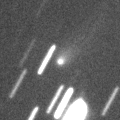
|
It brightened up to 14.5 mag in December (Dec. 22, Alan Hale). Now it is 17.4 mag (Mar. 13, E. Jehin, et al.). The orbit is extremely hyperbolic with e=3.35. It is the first interstellar comet in history. It will be fading after this, and will be fainter than 18 mag in April. In the Southern Hemisphere, it is observable in excellent condition. In the Northern Hemisphere, it will never be observable again.
Date(TT) R.A. (2000) Decl. Delta r Elong. m1 Best Time(A, h)
Mar. 14 12 54.43 -68 26.3 2.460 2.921 107 17.1 1:28 ( 0,-13)
Mar. 21 12 50.38 -69 19.4 2.537 3.032 110 17.3 0:57 ( 0,-14)
|

|
Now it is 15.9 mag (Feb. 18, Toshihiko Ikemura, Hirohisa Sato). It will be fading gradually after this. It will be fainter than 18 mag in April.
Date(TT) R.A. (2000) Decl. Delta r Elong. m1 Best Time(A, h)
Mar. 14 8 49.75 9 46.8 2.410 3.218 137 17.1 21:20 ( 0, 65)
Mar. 21 8 48.49 10 10.8 2.511 3.250 130 17.4 20:51 ( 0, 65)
|

|
Now it is 17.8 mag (Feb. 20, Toshihiko Ikemura, Hirohisa Sato). It will be fading slowly after this, and will be fainter than 18 mag in 2021. It is observable in good condition in the Northern Hemisphere. In the Southern Hemisphere, it is observable in the extremely low sky only in 2021 spring.
Date(TT) R.A. (2000) Decl. Delta r Elong. m1 Best Time(A, h)
Mar. 14 13 15.83 56 4.8 8.160 8.740 122 17.2 1:49 (180, 69)
Mar. 21 13 11.79 56 8.9 8.183 8.750 121 17.2 1:18 (180, 69)
|
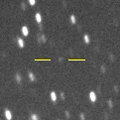
|
Now it is 17.4 mag (Feb. 23, Toshihiko Ikemura, Hirohisa Sato). It is expected to brighten up to 13 mag in 2022. In 2020, it is observable in excellent condition in the Southern Hemisphere. In the Northern Hemisphere, it will be unobservable soon. It will be observable again from autumn to winter, but it locating extremely low.
Date(TT) R.A. (2000) Decl. Delta r Elong. m1 Best Time(A, h)
Mar. 14 6 8.41 -31 47.6 7.487 7.645 95 17.3 19:30 ( 12, 22)
Mar. 21 6 9.35 -31 8.1 7.510 7.604 91 17.2 19:36 ( 19, 21)
|

|
Now it is 20.6 mag (Feb. 4, Pan-STARRS 1, Haleakala). It will brighten rapidly, and will brighten up to 9.5 mag in June. It is not observable in June. However, it stays observable in good condition until May while the comet is brightening, and after July while the comet will be fading.
Date(TT) R.A. (2000) Decl. Delta r Elong. m1 Best Time(A, h)
Mar. 14 11 35.29 -14 46.4 0.868 1.841 162 17.6 0:10 ( 0, 40)
Mar. 21 11 19.40 -13 46.0 0.782 1.759 162 17.3 23:20 ( 0, 41)
|

|
Now it is 17.6 mag (Feb. 3, ATLAS-HKO, Haleakala). It brightened up to 14 mag from autumn to winter in 2018. Now it is fading. It is observable at 17.5 mag in good condition from winter to spring.
Date(TT) R.A. (2000) Decl. Delta r Elong. m1 Best Time(A, h)
Mar. 14 13 31.16 -3 16.8 3.687 4.581 150 17.4 2:05 ( 0, 52)
Mar. 21 13 25.99 -3 13.8 3.677 4.620 158 17.3 1:32 ( 0, 52)
|

|
It will brighten up to 15.5 mag and will be observable in good condition from June to September.
Date(TT) R.A. (2000) Decl. Delta r Elong. m1 Best Time(A, h)
Mar. 14 19 0.44 -6 54.7 2.711 2.529 68 17.6 4:48 (309, 33)
Mar. 21 19 11.27 -5 46.9 2.610 2.503 72 17.5 4:37 (309, 35)
|
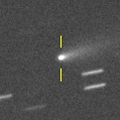
|
Now it is 16.0 mag (Feb. 17, Toshihiko Ikemura, Hirohisa Sato). It will fade out rapidly after this, and it will be fainter than 18 mag in late March.
Date(TT) R.A. (2000) Decl. Delta r Elong. m1 Best Time(A, h)
Mar. 14 11 12.64 16 50.9 1.234 2.208 164 17.5 23:42 ( 0, 72)
Mar. 21 11 9.25 17 1.7 1.293 2.250 158 17.9 23:11 ( 0, 72)
|
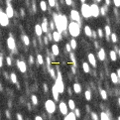
|
It will be observable at 16.5-17 mag from spring in 2020 to summer in 2021.
Date(TT) R.A. (2000) Decl. Delta r Elong. m1 Best Time(A, h)
Mar. 14 20 2.86 20 25.2 5.465 4.996 57 17.6 4:48 (270, 38)
Mar. 21 20 3.26 20 45.2 5.369 4.975 61 17.5 4:37 (273, 42)
|

|
Now it is 17.8 mag (Feb. 17, Toshihiko Ikemura, Hirohisa Sato). It will brighten up to 13 mag in 2022. In 2020, it is observable at 17.5 mag in good condition in spring. It locates somewhat low in the Southern Hemisphere.
Date(TT) R.A. (2000) Decl. Delta r Elong. m1 Best Time(A, h)
Mar. 14 10 22.39 21 50.0 3.602 4.514 153 17.6 22:52 ( 0, 77)
Mar. 21 10 18.53 22 1.3 3.638 4.502 146 17.6 22:21 ( 0, 77)
|
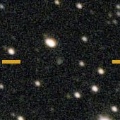
|
Now it is 17.8 mag (Feb. 23, Toshihiko Ikemura, Hirohisa Sato). It stays observable at 16.5 mag for a long time from 2020 to 2021. In the Northern Hemisphere, it is observable in excellent condition for a long time. In the Southern Hemisphere, it is not observable until 2021 summer.
Date(TT) R.A. (2000) Decl. Delta r Elong. m1 Best Time(A, h)
Mar. 14 1 12.02 68 32.4 6.662 6.441 72 17.7 19:30 (154, 33)
Mar. 21 1 16.57 68 0.7 6.712 6.423 68 17.7 19:36 (154, 31)
|
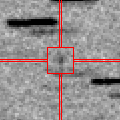
|
Now it is 18.6 mag (Feb. 23, Toshihiko Ikemura, Hirohisa Sato). It will brighten up to 15.5 mag from June to August, and it will be observable in good condition.
Date(TT) R.A. (2000) Decl. Delta r Elong. m1 Best Time(A, h)
Mar. 14 18 1.14 -12 0.7 2.259 2.362 83 17.9 4:48 (327, 37)
Mar. 21 18 12.28 -11 23.7 2.155 2.335 87 17.7 4:37 (328, 38)
|

|
Now it is 17.6 mag (Feb. 18, Toshihiko Ikemura, Hirohisa Sato). It will be fainter than 18 mag in late April.
Date(TT) R.A. (2000) Decl. Delta r Elong. m1 Best Time(A, h)
Mar. 14 12 40.34 9 49.3 9.852 10.804 162 17.8 1:14 ( 0, 65)
Mar. 21 12 38.94 10 7.9 9.852 10.822 166 17.8 0:45 ( 0, 65)
|
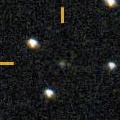
|
Now it is 17.5 mag (Feb. 18, Toshihiko Ikemura, Hirohisa Sato). It is observable at 17-18 mag for a long time from late 2019 to early 2021. It will fade out before it passes the perihelion.
Date(TT) R.A. (2000) Decl. Delta r Elong. m1 Best Time(A, h)
Mar. 14 3 13.36 7 13.6 5.450 4.947 54 17.8 19:30 ( 76, 31)
Mar. 21 3 18.18 7 51.1 5.523 4.934 49 17.8 19:36 ( 81, 26)
|
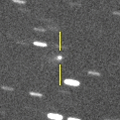
|
Fading. Now it is 18.0 mag (Feb. 26, Hidetaka Sato). It will be fainter than 18 mag soon.
Date(TT) R.A. (2000) Decl. Delta r Elong. m1 Best Time(A, h)
Mar. 14 17 53.92 -4 31.1 2.866 2.958 85 17.8 4:48 (324, 44)
Mar. 21 17 59.51 -3 45.0 2.822 3.003 90 17.9 4:37 (328, 46)
|
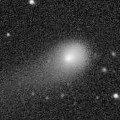
|
Fading. Now it is 18.3 mag (Feb. 18, Toshihiko Ikemura, Hirohisa Sato). It stays observable in good condition for a while.
Date(TT) R.A. (2000) Decl. Delta r Elong. m1 Best Time(A, h)
Mar. 14 7 46.61 23 5.3 6.676 7.235 120 17.8 20:17 ( 0, 78)
Mar. 21 7 43.51 22 52.5 6.829 7.279 113 17.9 19:46 ( 0, 78)
|
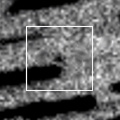
|
It is observable at 17.5 mag in good condition in spring.
Date(TT) R.A. (2000) Decl. Delta r Elong. m1 Best Time(A, h)
Mar. 14 17 52.87 -17 47.8 2.193 2.332 85 17.9 4:48 (332, 32)
Mar. 21 18 0.87 -17 42.4 2.134 2.361 90 17.9 4:37 (335, 33)
|
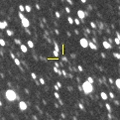
|
Now it is 17.8 mag (Oct. 9, Toshihiko Ikemura, Hirohisa Sato). It stays observable at 18 mag for a long time from 2019 to 2021.
Date(TT) R.A. (2000) Decl. Delta r Elong. m1 Best Time(A, h)
Mar. 14 19 13.54 -13 55.8 8.032 7.679 65 18.0 4:48 (311, 25)
Mar. 21 19 15.26 -14 12.2 7.922 7.679 72 17.9 4:37 (314, 27)
|

|
It passed the perihelion on Jan . 17. Now it is fading very rapidly. But it is observable in excellent condition.
Date(TT) R.A. (2000) Decl. Delta r Elong. m1 Best Time(A, h)
Mar. 14 6 44.81 8 16.0 0.825 1.468 107 21.2 19:30 ( 8, 63)
Mar. 21 6 58.98 10 12.9 1.009 1.580 103 22.0 19:36 ( 19, 64)
|
|
![]()
 29P/Schwassmann-Wachmann 1
29P/Schwassmann-Wachmann 1 C/2018 F4 ( PanSTARRS )
C/2018 F4 ( PanSTARRS ) 246P/NEAT
246P/NEAT C/2019 K1 ( ATLAS )
C/2019 K1 ( ATLAS ) C/2019 N1 ( ATLAS )
C/2019 N1 ( ATLAS ) 88P/Howell
88P/Howell 390P/2019 U1 ( Gibbs )
390P/2019 U1 ( Gibbs ) C/2019 F1 ( ATLAS-Africano )
C/2019 F1 ( ATLAS-Africano ) C/2017 K2 ( PanSTARRS )
C/2017 K2 ( PanSTARRS ) C/2018 A6 ( Gibbs )
C/2018 A6 ( Gibbs ) C/2016 M1 ( PanSTARRS )
C/2016 M1 ( PanSTARRS ) C/2019 K7 ( Smith )
C/2019 K7 ( Smith ) 114P/Wiseman-Skiff
114P/Wiseman-Skiff C/2017 M4 ( ATLAS )
C/2017 M4 ( ATLAS ) 124P/Mrkos
124P/Mrkos 112P/Urata-Niijima
112P/Urata-Niijima C/2018 W2 ( Africano )
C/2018 W2 ( Africano ) 101P/Chernykh
101P/Chernykh C/2019 C1 ( ATLAS )
C/2019 C1 ( ATLAS ) P/2019 Y2 ( Fuls )
P/2019 Y2 ( Fuls ) C/2018 U1 ( Lemmon )
C/2018 U1 ( Lemmon ) A/2017 U7
A/2017 U7 87P/Bus
87P/Bus 2I/2019 Q4 ( Borisov )
2I/2019 Q4 ( Borisov ) 78P/Gehrels 2
78P/Gehrels 2 C/2010 U3 ( Boattini )
C/2010 U3 ( Boattini ) C/2019 T4 ( ATLAS )
C/2019 T4 ( ATLAS ) 249P/LINEAR
249P/LINEAR (944) Hidalgo
(944) Hidalgo 257P/Catalina
257P/Catalina 155P/Shoemaker 3
155P/Shoemaker 3 C/2017 Y2 ( PanSTARRS )
C/2017 Y2 ( PanSTARRS ) 117P/Helin-Roman-Alu 1
117P/Helin-Roman-Alu 1 C/2019 T3 ( ATLAS )
C/2019 T3 ( ATLAS ) 115P/Maury
115P/Maury C/2014 B1 ( Schwartz )
C/2014 B1 ( Schwartz ) 173P/Mueller 5
173P/Mueller 5 C/2019 F2 ( ATLAS )
C/2019 F2 ( ATLAS ) C/2015 O1 ( PanSTARRS )
C/2015 O1 ( PanSTARRS ) 175P/Hergenrother
175P/Hergenrother C/2017 K5 ( PanSTARRS )
C/2017 K5 ( PanSTARRS ) 321P/SOHO
321P/SOHO![]()










































